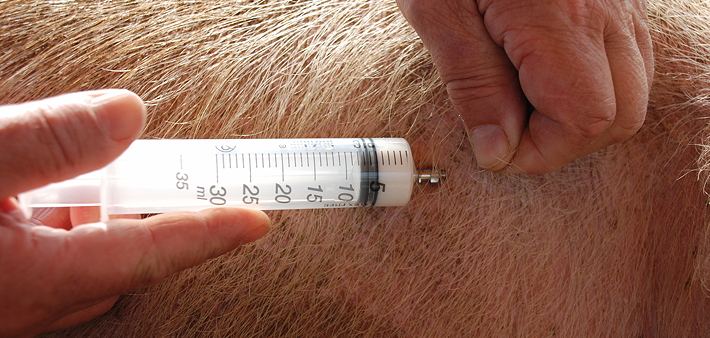A new electronic medicines book for pigs – eMB-Pigs – has been developed to help producers take their medicine recording into the 21st century, simplifying the process of accurately recording and monitoring on-farm antibiotic usage, in light of proposed EU legislation.
According to AHDB Pork’s technical veterinary team manager, Martin Smith, globally, the use of antibiotics within the medical and veterinary sector has been under increasing scrutiny during the past few years due to rising concerns about antibiotic-resistant bacteria that threaten human health.
“Because of these concerns, it’s particularly important that now, more than ever, as an industry, we’re able to accurately record and report our antibiotic usage levels on a pig specific basis,” he says.
However, this is where problems arise, because the pig industry currently has no clear understanding of its total antibiotic usage.
“We know that about 75% of the total antibiotics sold in the UK for animal use are authorised for use in pig and/or poultry production,” Mr Smith adds, “however, we don’t know how much of that is used in pig production specifically.
“What’s more, the European Union (EU) has drafted legislation that proposes a requirement for all EU member states to supply antibiotic usage data by species, which presents another question mark.”
Mr Smith says this is why the eMB-Pigs system has been developed.
“As an industry, we believe that the collection and collation of on-farm data is key to getting a better understanding of the pig industry’s total antibiotics usage. And, by law, each pig unit already has to keep a medicine book on-farm, whether this is paper-based, or saved in an Excel spreadsheet format,” he adds.
“The full system will be launched in April, but from this month producers can download and start using the official eMB-Pigs spreadsheet to replace their current system.
“Producers can choose to submit their data quarterly, biannually or yearly, but quarterly will provide the most accurate medicine use trend analysis for the producer. It’s important to note that the recording window starts at the beginning of each calendar year – and the first window of upload will be in April.
“Following submission to an online portal, recorded data is anonymised and a trend report is sent back to the producer that will be a really valuable benchmarking exercise as it means that producers will be able to assess their usage against pig industry standards.
“Antibiotics are a significant input cost in pig production,” Mr Smith says, “so, if we can help producers better target their antibiotic use, combined with alternative management techniques, we can help them to minimise antibiotic usage and, as a result, reduce the cost of production.”
Mr Smith highlights that the data submitted will also help the UK to record antimicrobial usage on-farm, which will help present a far more accurate picture to the EU, which is scrutinising the use of antibiotics throughout the world at all levels.
“What’s more, the eMB-Pigs will also automatically fulfil the requirements of Red Tractor assurance, mitigating the need for producers to tally up their total usage annually,” he adds.
More details about the method of data submission will be shared in April. It’s worth noting that producers can wait until the end of the year, if they prefer, to submit their medicines book but, if they do this, they won’t benefit from the more frequent quarterly data trend analysis reports.
Producers using their own online recording systems should speak directly to Martin Smith or AHDB Pork’s knowledge transfer managers to discuss the integration with the new system.

Working together to reap the rewards of monitoring antimicrobials usage
Vet David Chennells, senior partner at Acorn House Veterinary Surgery, has worked closely with Bedfordia Farms’ pig production manager Christian Andersen to reduce its total antibiotic usage by 28% in the past two years.
Mr Chennells explains that Bedfordia’s 1,100 breeding sows are located on two breeding farms, and replacement Landrance/Large white F1 gilts are produced from a nucleus herd of 160 sows for both breeding units. The progeny of these two parallel units are then moved at 37kg to be finished at a third unit.
“I’ve worked with Bedfordia for almost 30 years now, but during the past five years I’ve worked particularly closely with Christian and his team to reduce antibiotic usage on-farm while maintaining health and welfare levels and maximising productivity.
“However, it’s only really in the past three years that we’ve been seeing positive results, and I believe that’s down to the fact that we’ve been analysing the records of antibiotic usage data in detail.”
Mr Chennells explains that the business records and collates the total volume of injectable antibiotics administered every quarter, and then compares the current quarter with the previous quarter.
“By analysing our data in this way, we’ve been able to rationalise the farm’s use of antibiotics,” he says. “We’ve reduced the range to relatively few products that we use in the main, and only use a handful of other antibiotics sporadically.
“I’m really happy to be able to say that this has helped Christian and the team reduce their on-farm antibiotic usage by a total of 28% in the past two years.
“We’ve also withdrawn most of the in-feed medication in the weaner/grower stages, and replaced it with water medication that’s only used as and when it’s needed.”
Mr Andersen highlights that this has obviously had a really positive impact on the farm’s bottom line, but notes that health and welfare of the pigs hasn’t been affected.
“Thoroughly analysing and scrutinising our antibiotic usage in this way has been really effective and has helped us reduce our overheads in terms of medication costs,” he says. “However, throughout the whole process the health and welfare of stock has always been priority and we’ve used simple, straightforward techniques to help try and reduce our need to treat with antibiotics.”
Mr Chennells explains that he’s encouraged Christian and his team to use best practice techniques to reduce their total antibiotics usage.
“My opinion is that prevention is always better than cure,” he says. “Therefore, if there’s a vaccine use it. Second, if there’s an underlying fault, correct it. This could be as simple as cleaning and disinfecting buildings, improving ventilation systems, or even cleaning the ventilation system to ensure it’s working effectively.
“It really comes down to improving the pigs’ overall housed environment so the risk of disease outbreak is reduced.”
Mr Chennells says he would encourage producers to use the electronic medicine book, and especially the trend reports.
“With increasing global pressure with regards to antimicrobial resistance, it’s more important than ever for producers to really understand their own usage, and be aware of how much they are actually using so that they can make changes and hopefully reduce their total usage,” he adds.
“Producers need to take the opportunity to critically evaluate what they’re using, when they’re using it, and why. I’ve always had that policy, and it’s one that I’d really urge all famers to try and apply to their businesses.”




